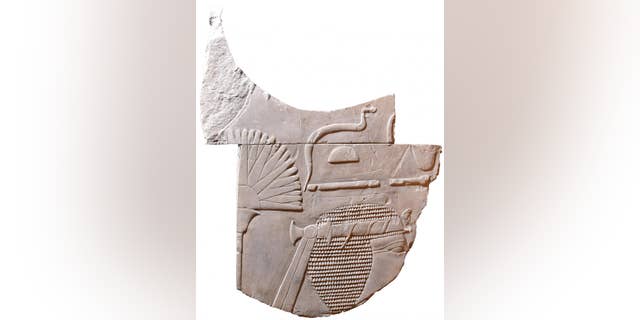By James Rogers, Fox News
March 26, 2018
A rare ancient artifact depicting the famous female pharaoh Hatshepsut has surfaced in the U.K., stunning experts.
 |
| The front of the artifact (The Egypt Centre, Swansea University) |
Consisting of two limestone fragments that have been glued together, the artifact had been in storage for 20 years before it was chosen for an object handling session by students of Swansea University in Wales. While the artwork was being analyzed by the students, Swansea University Egyptology lecturer Dr. Ken Griffin noticed something unusual.
Griffin recognized the artwork’s iconography as being similar to carvings within the temple of Hatshepsut at Deir el-Bahri in Luxor, Egypt. The front of the artifact depicts the head of a figure whose face is missing, with the remains of a fan. A uraeus, or cobra, is depicted on the figure’s forehead and hieroglyphics can also be seen above her head.
The decoration of the fan, the figure’s hair, the uraeus and her headband are all similar to images found at Deir el-Bahri. The hieroglyphs, which use a female pronoun, are also found in text at the temple.
The unusual artifact, which is held in Swansea University’s Egypt Centre, thrilled Griffin and his students.
Hatshepsut, who reigned from about 1478 B.C. to 1458 B.C., is one of only a handful of female pharaohs. “Early in her reign she was represented as a female wearing a long dress, but she gradually took on more masculine traits, including being depicted with a beard,” explained Swansea University, in its statement.
The University obtained the artwork in 1971 with other artifacts that once belonged to the pharmaceutical mogul Sir Henry Wellcome.
The head of a man with a short beard is depicted on the rear of the mysterious fragment. “Initially there was no explanation for this, but it is now clear that the upper fragment had been removed and recarved in more recent times in order to complete the face of the lower fragment,” explained Swansea University, in its statement. “The replacement of the fragment below the figure would also explain the unusual cut of the upper fragment."
The recent work on the fragment’s rear may have been done by an antiques dealer, auctioneer, or previous owner to increase the piece’s value or attractiveness, the University added.
Experts think that the artifact came from Deir el-Bahri but more research is needed to confirm this.
No comments:
Post a Comment